Home > About Us > Sustainability Management > Sustainability Report > Sustainability Report 2013 > Promoting Resource Recycling
 Promoting Resource Recycling
Promoting Resource Recycling
In order to make effective use of limited resources, the Kobe Steel Group implements measures to control waste at each of its sites.
Additionally, adding value to byproducts created during the manufacturing processes allows us to pursue greater levels of reuse and recycling.
Promoting Waste Control and Recycling
![]()
In fiscal 2012 a total of 4.97 million tons of byproduct materials were created by the Kobe Steel Group, with approximately 98.7% of those materials from the Iron & Steel Business. At steelworks we strive to recycle and add value to secondary materials produced during iron and steelmaking such as slag1 and dust. In fiscal 2012 the recycling ratio at all Kobe Steel sites was 96.2%, while the overall ratio for the Kobe Steel Group was 95.8%.
In fiscal 2012, through continuation of initiatives for the effective use of slag and dust, we strove to further reduce the amount of material consigned to landfills.
In addition to recycling, we also follow a fundamental policy of minimizing the initial production of waste through thorough adjustments to the amount of raw materials and auxiliary materials used.
Groupwide, Kobe Steel consigned approximately 190,000 tons2 of waste to landfills. We plan to continue to reduce this amount through measures such as controlling waste, increasing recycling, developing new recycling technologies and adding value to byproducts, so as to meet the fiscal 2015 targets set (for reducing waste and increasing recycling) in voluntary action plans for each industry sector.
1 Slag is a byproduct recovered from ironmaking and steelmaking
2 Due to factors such as an increase in the amount of waste heat-resistant materials and excavated sediment to be treated, this amount increased by approximately 10% compared to fiscal 2011.
Byproducts by Business Unit (includes Group Companies)
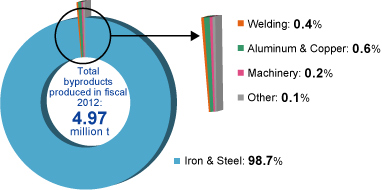
Byproducts, Amount Recycled and Recycling Ratio (Kobe Steel)
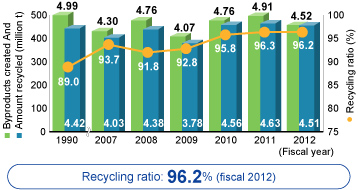
Recycling Initiatives
![]()
In each business unit and at each of our facilities, we implement action programs to reduce levels of waste consigned to landfills, and strive to add value through measures to reduce and reuse waste, develop recycling technologies, and create new avenues for use.
Iron & Steel Business
![]()
Recycling of Waste and Byproducts
![]()
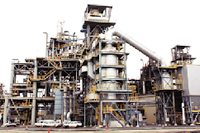
Steel dust recycling plant
As a result of development of technologies for the recycling of slag and dust as well as new recycling uses, in fiscal 2012 the Kobe Works, Kakogawa Works and Tagasago Works reduced waste consigned to landfills by approximately 160,000 tons.
A steel dust recycling plant under a joint venture between Kobe Steel and Nippon Steel Corporation (currently Nippon Steel & Sumitomo Metal Corporation) went into operation in October 2011. The recycling plant, situated at NSSC’s Hirohata Works, processed approximately 80,000 tons of steel dust produced at the Kobe Works and Kakogawa Works into iron units. In the future we will strive to continue using this plant to raise recycling rates, thus lowering the amount of waste consigned to landfills.
In fiscal 2012, 2.16 million tons of blast furnace slag* and 1.18 million tons of steelmaking slag* were produced at the Kakogawa Works and Kobe Works.
*Blast furnace slag, steelmaking slag: Byproducts classified as iron and steel slag produced in the blast furnace and the steelmaking processes, respectively.
Recycling Ratio (Kakogawa Works)
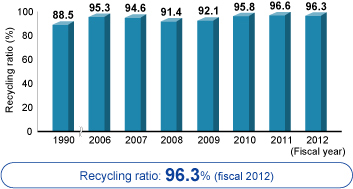
Slag from these sources is recycled as materials for such uses as cement and roadbeds. In particular, blast furnace cement utilizing ground granulated blast furnace slag, when compared to ordinary cement, helps to control alkaline aggregate reaction and reduce energy consumption during concrete production, making it a valued market commodity for its ability to cut CO2. emissions. Additionally, as an alternative to natural sand, using ground granulated blast furnace slag as fine aggregate for concrete helps to conserve nature.
Steel slag, meanwhile, is aged using steam to control the distensibility resulting from free lime in the slag, and then used as a material in roadbeds. By utilizing steam aging facilities, nearly all of the steel slag produced can be used effectively.
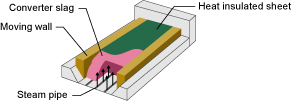
Steam aging facilities
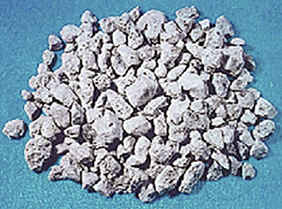
Steel slag
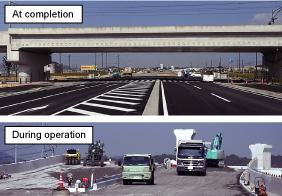
Used as roadbed materials
Development of Artificial Reefs Using Steel Slag
![]()
In order to utilize steel slag produced during steelmaking as a material to help conserve and restore the environment, Kobe Steel, in cooperation with Shinko Slag Co., Ltd., Shinko Kenzai Ltd., and Kobelco Research Institute Inc., created steel reefs for seaweed and fish at the Ieshima Islands (off Himeji, Hyogo Prefecture), at the north bank of Kobe Airport Island, and in the waters off the town of Yonabaru in Okinawa Prefecture. Kobe Steel participates in collaborative research between industry, government and academia to improve seaweed and fishery cultivation.
Currently a lush diversity of seaweed and aquatic life has been confirmed in the environment surrounding the steel reefs. The enriched iron and mineral content of the water, due to the use of steel slag, is thought to be a contributing factor.

Fish migrating near the reef
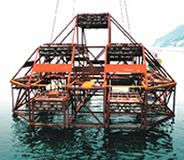
Steel reef
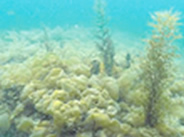
Lush seaweed growth on reef
Welding Business
![]()
The Welding Business pursues a variety of measures involving investigating and setting targets for waste. The know-how behind such measures is shared through regular meetings.
In order to decrease waste consigned to landfills, we work to improve the collection of waste flux and lubricant produced during the production of welding materials, reuse these materials, and raise output levels.
Aluminum & Copper Business
![]()
Drawing on the exceptional initiatives for controlling waste that are in place at individual sites, such as those for the effective use of dross produced from aluminum melting furnaces, the Aluminum & Copper Business aims for horizontal expansion of measures so as to raise the resource recycling rate of the business unit as a whole. Additionally, we actively work to reduce waste amounts through such methods as dehydrating the sludge produced using wastewater treatment facilities and concentrating liquid waste created by manufacturing processes.
As a result, a 94.7% resource recycling ratio was achieved in fiscal 2012 for the Moka Plant, while a 99.9% ratio was maintained at the Chofu Works.
Recycling Ratio (Moka Plant)
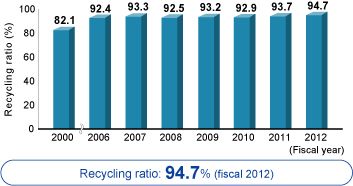
Recycling Ratio (Chofu Works)
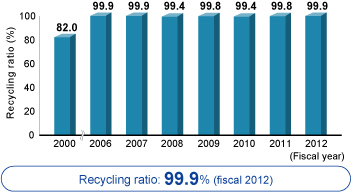
Machinery Business
![]()
In the Machinery Business, a high resource recycling ratio is maintained through the careful solidification of previously enacted measures. The Takasago Machinery Center, which produces industrial machinery such as nonstandard compressors, has been introducing measures to reduce waste (from the source) and increase recycling. Additionally, through recycling measures such as the introduction of returnable containers for product packing, the Harima Plant, which produces standard compressors, maintains zero waste being consigned to landfills.


